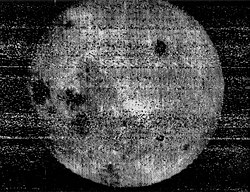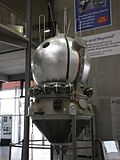Space Race
The Space Race was a 20th-century competition between two Cold War enemies, the Soviet Union (USSR) and the United States (US), to achieve better spaceflight capability than the other. It had its origins in the intercontinental ballistic missile-based nuclear arms race between the two nations following World War II. Both governments saw having better spaceflight technology as necessary for national security. The Space Race enabled the first launches of artificial satellites, uncrewed space probes to the Moon, Venus, and Mars, and human spaceflight in low Earth orbit and ultimately to the Moon.[1]
The competition started on August 2, 1955, when the Soviet Union responded to the US announcement four days earlier of intention to launch artificial satellites during the "International Geophysical Year" (July 1, 1957 to December 31, 1958), by declaring they would also launch a satellite "in the near future". The Soviet Union achieved the first successful artificial satellite launch on October 4, 1957 of Sputnik 1, and sent the first human to space with the orbital flight of Yuri Gagarin on April 12, 1961. The USSR demonstrated an early lead in the race with these and other early firsts over the next few years, including flight durations measured in days instead of hours, the first multi-person crewed spaceflight, and the first spacewalk.[2] In 1966 the Soviet Venera became the first probe to land on Venus.
But the USSR lost its early lead after US president John F. Kennedy raised the stakes by setting a goal of "landing a man on the Moon and returning him safely to the Earth".[3] American spaceflight capability overtook the Soviets with flights lasting up to two weeks long; two craft meeting in space (rendezvous) and joining (docking); astronauts working outside spacecraft; and using high-energy liquid hydrogen as rocket fuel in the Saturn family of rockets. Kennedy's Moon landing goal was achieved in July 1969, with the flight of Apollo 11, which sent and returned three men and landed two of them,[4][5][6] the only achievement far outweighing any combination of Soviet achievements.[7] The USSR pursued two crewed lunar programs, but failed to develop a launch vehicle powerful enough to land one human on the Moon before the US, and eventually canceled them to focus on Earth orbital space stations, while the US landed five more Apollo crews on the Moon.[8]
A period of détente followed with the April 1972 agreement on a co-operative Apollo-Soyuz Test Project (ASTP), resulting in the July 1975 rendezvous in Earth orbit of a US astronaut crew with a Soviet cosmonaut crew and joint development of an international docking standard APAS-75. Apollo–Soyuz began a period of transition from the Space Race to an age of US / Russian space cooperation[9][7] by December 1991, when the dissolution of the Soviet Union brought the end of the Cold War and enabled the Shuttle-Mir and International Space Station programs between the US and the newly founded Russian Federation.[10][11]
Space Race Media
Wernher von Braun's space station concept (1952)
The Soviet stable of Sputnik, Vostok, Voskhod, and Soyuz launch vehicles were all derivatives of the R-7 Semyorka ICBM.
The US stable of Explorer 1, Mercury, Gemini, and Apollo launch vehicles were a varied group of ICBMs and the NASA-developed Saturn IB rocket.
One of the first reports of Sputnik 1 by Universal Newsreel on October 7, 1957
William Hayward Pickering, James Van Allen, and von Braun display a model of Explorer 1 at a news conference after confirmation the satellite was in orbit.
Laika on a Romanian post stamp
A 1964 Stamp with Yuri Gagarin, and an intentionally inaccurate Vostok
References
- ↑ history.com, Space Race
- ↑ Siddiqi, Asif A. (2003). The Soviet Space Race with Apollo. Gainesville: University Press of Florida. p. 460. ISBN 0-8130-2628-8.
- ↑ Kennedy, John F. (May 25, 1961). Special Message to Congress on Urgent National Needs (Motion picture (excerpt)). Boston, MA: John F. Kennedy Presidential Library and Museum. Accession Number: TNC:200; Digital Identifier: TNC-200-2. Retrieved August 1, 2013.
- ↑ "Apollo 11 Command and Service Module (CSM)". NASA Space Science Data Coordinated Archive. Archived from the original on February 10, 2021. Retrieved November 20, 2019.
- ↑ "Apollo 11 Lunar Module / EASEP". NASA Space Science Data Coordinated Archive. Archived from the original on August 3, 2019. Retrieved November 20, 2019.
- ↑ "Apollo 11 Mission Summary". Smithsonian Air and Space Museum. Archived from the original on February 9, 2021. Retrieved March 29, 2021.
- ↑ 7.0 7.1 Both the Apollo 11 Moon landing and the ASTP have been identified as the end of the Space Race,Samuels, Richard J., ed. (2005). Encyclopedia of United States National Security (1st ed.). Sage Publications. p. 669. ISBN 978-0-7619-2927-7.
Most observers felt that the U.S. moon landing ended the space race with a decisive American victory. […] The formal end of the space race occurred with the 1975 joint Apollo-Soyuz mission, in which U.S. and Soviet spacecraft docked, or joined, in orbit while their crews visited one another's craft and performed joint scientific experiments.
- ↑ Williams, David R. (December 11, 2003). "Apollo Landing Site Coordinates". NASA Space Science Data Coordinated Archive. NASA. Archived from the original on December 25, 2018. Retrieved September 7, 2013.
- ↑ U.S.-Soviet Cooperation in Space (PDF) (Report). US Congress, Office of Technology Assessment. July 1985. pp. 80–81. Retrieved June 13, 2018.
- ↑ Boyle, Alan (March 23, 2001). "Russia bids farewell to Mir". NBC News (New York). http://www.nbcnews.com/id/3077781/ns/technology_and_science-space/t/russia-bids-farewell-mir/#.VXyY2BNVhHw. Retrieved June 13, 2015.
- ↑ Garcia, Mark (April 30, 2015). "ISS Facts and Figures". International Space Station. NASA. Archived from the original on June 3, 2015. Retrieved June 13, 2015.
Other websites
- The Space Race Archived 2011-05-20 at the Wayback Machine
- Space Race -Citizendium










